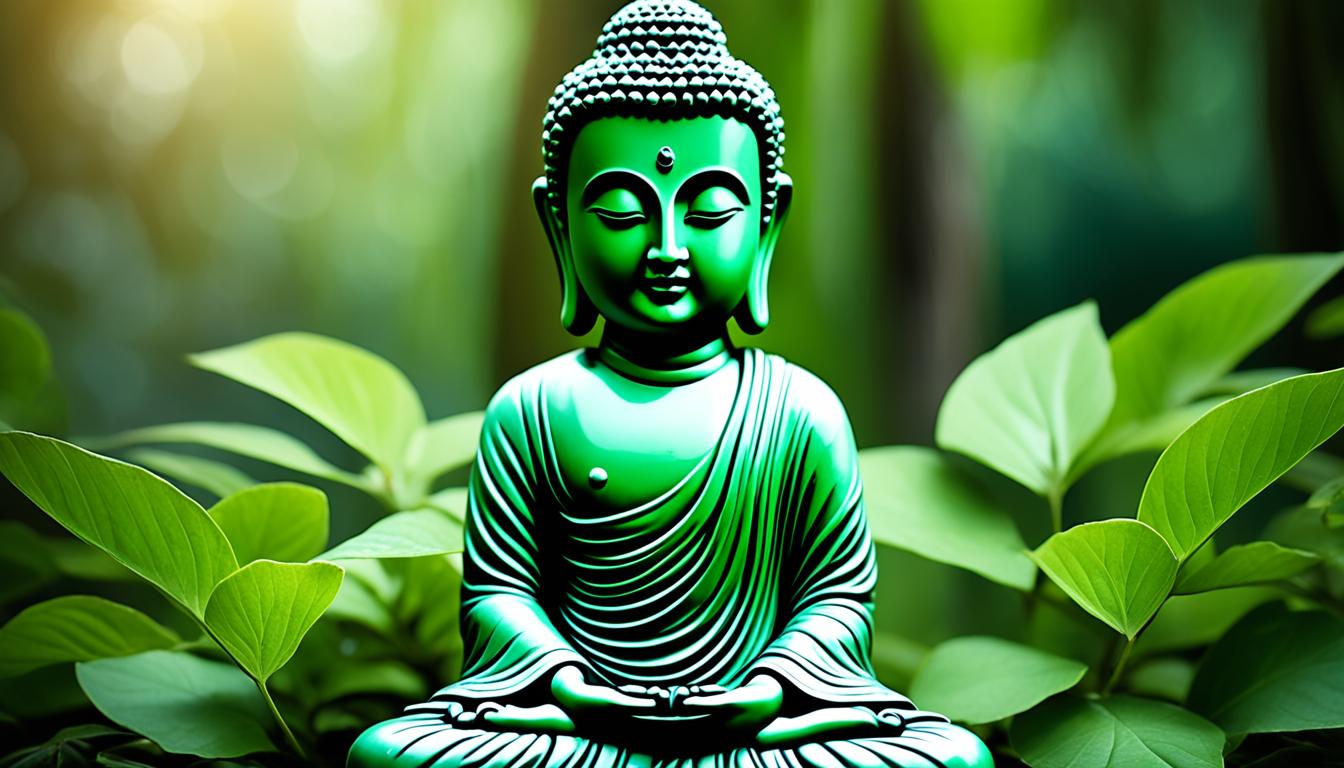“Do not dwell in the past, do not dream of the future, concentrate the mind on the present moment.” – Buddha
Welcome to a journey of self-discovery and inner peace. Buddhism, with its rich teachings and practices, offers profound insights that can guide you towards spiritual enlightenment and personal growth. In a world often filled with chaos and distractions, Buddhism provides a path towards tranquility and mindfulness.
Through meditation practices and the application of Buddhist philosophy, you can cultivate a deeper understanding of yourself and the world around you. The teachings of the Buddha, known as dharma teachings, offer wisdom that resonates across time and cultures. Whether you are seeking solace, answers, or a more meaningful existence, Buddhism offers a path to navigate the complexities of life.
In this article, we will explore the fundamental principles of Buddhism, such as the Four Noble Truths and the bodhisattva path. We will delve into the transformative power of mindfulness practice and the pursuit of inner peace. From embracing impermanence to finding balance through the Middle Way, we will uncover the practical applications of Buddhist teachings in daily life.
So, are you ready to embark on a transformative journey? Join us as we delve into the realms of Buddhist wisdom, uncovering the secrets to tranquility and personal enlightenment.
Key Takeaways:
- Explore the profound teachings and practices of Buddhism.
- Discover the path to spiritual enlightenment and personal growth.
- Learn how mindfulness practice can bring tranquility to your everyday life.
- Uncover the practical applications of Buddhism in navigating modern challenges.
- Cultivate inner peace through the pursuit of wisdom and compassion.
The Symbolism and Cultural Significance of the Child Buddha Statue
The Child Buddha Statue holds a profound symbolism and cultural significance, representing serenity, innocence, and enlightenment. This exquisite artwork embodies the purity associated with childhood, reminding us that enlightenment is attainable by all. Its presence serves as a visual sanctuary, inviting us to reflect and cultivate mindfulness in our contemporary spaces.
In the Theravada tradition, the Child Buddha Statue holds a special place, honoring the early life and human experience of Siddhartha Gautama, the historical figure behind Buddhism. It pays homage to Siddhartha’s journey and the crucial moment known as the Four Sights, which propelled him towards his spiritual quest for enlightenment. The statue beautifully captures the essence of this transformative phase, evoking a sense of awe and inspiration.
With its intricate details and artistic expression, the Child Buddha Statue captivates hearts and minds. Its serene countenance and gentle posture evoke a sense of tranquility, inviting us to pause and find solace in its presence. The statue’s cultural significance and timeless beauty make it a cherished symbol of wisdom, compassion, and the pursuit of spiritual awakening.
Through its symbolism and intricate craftsmanship, the Child Buddha Statue serves as a reminder of the profound teachings and cultural richness associated with Buddhism. Whether it graces a temple, meditation space, or personal altar, this sacred representation of the Child Buddha inspires us to seek inner balance, embrace innocence, and embark on our own journey towards enlightenment.
Finding Inner Peace through Buddhist Teachings
Discovering inner peace can be a transformative journey that aligns with the principles of Buddhist philosophy. Incorporating key teachings such as impermanence, mindfulness, the Middle Way, compassion, and the Four Noble Truths can guide you towards achieving a state of calm and harmony. Let’s explore how these concepts can bring about serenity and tranquility in your life.
The Concept of Impermanence
In Buddhism, impermanence is recognized as a fundamental truth of existence. It teaches us that everything in life is constantly changing and transient. By accepting this impermanence, we can release our attachments and find a deeper sense of peace. Embracing impermanence allows us to approach life’s ups and downs with equanimity and resilience.
Mindfulness: Being Present in the Moment
Mindfulness is a practice that encourages us to be fully present and engaged in the current moment. By cultivating mindfulness, we can develop a heightened awareness of our thoughts, emotions, and sensations, without judgment. This state of conscious attentiveness enables us to let go of distractions and find inner calm. Mindfulness is often cultivated through meditation or by incorporating mindful activities into our daily routines.
The Middle Way: Balance and Moderation
The Middle Way is a central concept in Buddhism that emphasizes finding balance and moderation in all aspects of life. It encourages us to avoid extremes and to navigate the middle path between indulgence and asceticism. By embracing the Middle Way, we can cultivate a sense of equilibrium, fostering inner peace and avoiding unnecessary suffering.
Cultivating Compassion
Compassion lies at the heart of Buddhist teachings. By cultivating compassion towards ourselves and others, we develop a deeper sense of interconnectedness and empathy. Compassion allows us to let go of judgment and criticism, replacing them with understanding and kindness. It fosters harmony within ourselves and in our relationships, nurturing inner peace.
The Four Noble Truths: Understanding the Nature of Suffering
The Four Noble Truths provide a framework for understanding and addressing the nature of suffering. These truths teach us that suffering is an inherent part of human existence, but also offer guidance on how to overcome it. They highlight the causes of suffering, the path to its cessation, and the way to achieve liberation from suffering. By embracing and understanding the Four Noble Truths, we can find solace and transform our experiences.
Silence and Letting Go
In the pursuit of inner peace, silence and letting go play crucial roles. Silence allows us to cultivate stillness and create space for self-reflection. It provides an opportunity to quiet the mind, reduce distractions, and deepen our connection with the present moment. Letting go involves releasing attachments, desires, and negative emotions, freeing ourselves from unnecessary burdens and finding greater peace within.
By incorporating these Buddhist teachings into your life, you can embark on a path towards inner peace and personal growth. Embrace impermanence, practice mindfulness, find balance through the Middle Way, cultivate compassion, understand the Four Noble Truths, and embrace silence and letting go. These principles can guide you on a transformative journey towards lasting serenity and tranquility.

| Teaching | Description |
|---|---|
| Impermanence | Recognizing the ever-changing nature of life and finding peace through acceptance. |
| Mindfulness | Cultivating present-moment awareness and deepening our connection with the here and now. |
| The Middle Way | Embracing balance and moderation in all aspects of life, avoiding extremes. |
| Compassion | Cultivating empathy, kindness, and understanding towards ourselves and others. |
| Four Noble Truths | Understanding the nature of suffering and the path to liberation from it. |
| Silence and Letting Go | Finding solace and peace by embracing stillness and releasing attachments. |
Exploring the Eightfold Path: A Guide to Wisdom and Enlightenment
The Eightfold Path is a central teaching in Buddhism, offering a comprehensive guide for personal and ethical development. It consists of eight components, each playing a vital role in shaping moral conduct, mental discipline, and wisdom. By following the Eightfold Path, practitioners are guided towards enlightenment and liberation from suffering.
- Right View: Develop a clear understanding of the Four Noble Truths and the nature of reality.
- Right Intention: Cultivate wholesome, ethical intentions that promote compassion and non-harm.
- Right Speech: Practice honest, kind, and skillful communication.
- Right Action: Engage in actions that promote wellbeing and refrain from harmful behaviors.
- Right Livelihood: Earn a living in a manner that aligns with moral and ethical principles.
- Right Effort: Cultivate effort and determination in the practice of mindfulness and ethical conduct.
- Right Mindfulness: Develop awareness and attentiveness to the present moment, observing thoughts and sensations without judgment.
- Right Concentration: Cultivate deep meditative states to develop clarity and focus of mind.
Each aspect of the Eightfold Path is interconnected and supports the others, forming a holistic framework for personal growth and spiritual development. The path provides practitioners with practical guidance and tools for leading a meaningful and compassionate life.
By embracing the Eightfold Path, individuals can cultivate wisdom, compassion, and mindfulness, ultimately finding profound peace, harmony, and liberation within themselves.

Incorporating Buddhism in Daily Life: Practical Applications
Buddhism offers valuable teachings that can be incorporated into daily life, enhancing our well-being and fostering a sense of serenity and mindfulness. By bringing Buddhist elements into various aspects of our lives, we can create spaces of tranquility and find solace in the midst of our busy routines.
1. Home Décor: Creating a Calm Environment
Placing Buddhist symbols or statues in prominent areas of your home can create a sense of calm and mindfulness. Whether it’s a serene Buddha statue or a simple lotus flower artwork, these decorative elements serve as gentle reminders to cultivate inner peace in your daily life. Consider choosing items that align with your personal aesthetic and resonate with your spiritual journey. The presence of such symbols can create an atmosphere of serenity, enabling you to find moments of stillness and reflection amidst the chaos of the outside world.
2. Meditation and Yoga Spaces: Nurturing Spiritual Experiences
Designating dedicated spaces in your home for meditation and yoga can provide a sanctuary for spiritual practices. Set up a corner or room where you can engage in mindfulness meditation or perform yoga asanas. Fill these spaces with soft lighting, comfortable cushions or mats, and soothing incense or candles to create an ambiance conducive to inner calm and self-reflection. Having a designated area for your spiritual practices can help cultivate a routine and make it easier to integrate daily moments of tranquility into your life.

3. Gifts of Serenity: Spreading Peace and Joy
When choosing gifts for your loved ones, consider Buddhist items that convey wishes of peace and joy. Mala beads, prayer flags, or mindfulness journals can serve as thoughtful reminders to live mindfully and embrace compassion. These gifts provide an opportunity for your loved ones to explore Buddhism and deepen their own spiritual journeys. By sharing the gifts of serenity, you can inspire others to find their own paths of inner peace.
4. Workplace Serenity: Fostering a Centered Approach
Bringing elements of Buddhism into the workplace can promote a calm and centered approach to work. Place a small Buddha statue or a peaceful painting on your desk to create a visual anchor for mindfulness. Consider incorporating short meditation breaks into your work routine to recharge and refocus. By infusing your workspace with Buddhist elements, you can cultivate a sense of tranquility and resilience, even amidst the demands of a fast-paced work environment.
5. Educational Spaces: Inspiring Curiosity and Open-Mindedness
Incorporating Buddhist symbolism in educational spaces can inspire curiosity and open-mindedness among students. Hang colorful prayer flags in classrooms or display books on Buddhist philosophy in libraries. By exposing students to different spiritual traditions, we encourage respect for diverse perspectives and provide opportunities for self-discovery. Buddhist symbolism can also serve as a reminder of the importance of mindfulness and compassion in their academic and personal journeys.
By incorporating Buddhism into daily life, we can infuse our routines with a sense of peace and purpose. Whether it’s through home décor, designated meditation spaces, thoughtful gifts, workplace serenity, or educational inspiration, the teachings of Buddhism offer practical applications that can lead to a more mindful, harmonious, and fulfilling life.
Conclusion
Buddhism offers a transformative spiritual journey that can lead you towards inner peace, personal growth, and a deeper understanding of yourself and the world around you. By embracing the teachings of mindfulness, compassion, impermanence, and the pursuit of wisdom, you can embark on a path of self-discovery and harmony.
Through the incorporation of Buddhist principles into your daily life, you can cultivate a sense of inner peace that extends to all aspects of your being. By practicing mindfulness and embracing the present moment, you can find solace in the midst of life’s challenges and uncertainties.
As you navigate your spiritual journey, remember the importance of compassion towards yourself and others. Cultivating empathy and kindness can foster a deeper sense of connection and harmony in your relationships and interactions.
By following the Eightfold Path, a guide to wisdom and enlightenment, you can develop moral conduct, mental discipline, and wisdom. Each step of the Eightfold Path, from cultivating right view and intention to practicing right mindfulness and concentration, contributes to your personal growth and spiritual development.
Incorporating Buddhist principles into your daily life, whether through home décor, meditation and yoga spaces, or the gifting of serenity, can further enhance your connection to Buddhism and support your journey towards inner peace and harmony.
FAQ
What teachings does Buddhism offer?
Buddhism offers teachings on mindfulness, compassion, impermanence, the Middle Way, the Four Noble Truths, and more.
What is the significance of the Child Buddha Statue?
The Child Buddha Statue symbolizes innocence and purity associated with childhood, reminding us that enlightenment is attainable by all.
How can Buddhism help in finding inner peace?
Buddhism teaches the importance of embracing impermanence, practicing mindfulness, finding balance through the Middle Way, cultivating compassion, understanding the Four Noble Truths, and embracing silence and letting go.
What is the Eightfold Path?
The Eightfold Path is a core teaching in Buddhism that includes components such as right view, intention, speech, action, livelihood, effort, mindfulness, and concentration. It serves as a guide for personal and ethical development leading towards enlightenment.
How can Buddhism be incorporated into daily life?
Buddhism can be incorporated into daily life through the use of Buddhist symbols or statues at home, dedicating spaces for mindfulness and meditation, gifting Buddhist items, bringing Buddhist elements into the workplace, and inspiring curiosity and open-mindedness in educational settings.
What does Buddhism offer in terms of personal growth and inner peace?
Buddhism offers a path towards personal growth and inner peace through its teachings on mindfulness, compassion, impermanence, wisdom, and by following the Eightfold Path.

